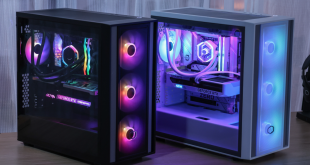Each side panel is lined with a large segment of 3.5mm-thick foam to absorb noise-causing vibrations. The panels feel sturdy and do not flex considerably when a torsion (twisting) load is placed upon them.
The Corsair Carbide 330R's interior is around the ‘standard' size for a mid-tower ATX chassis. Four cut-outs increase the tidiness of routing cables to the busy areas around the motherboard and power supply. An additional cut-out is also found in its ideal position to serve the 8-pin CPU power cable.
Corsair chooses not to fit the cable management cut-outs with rubber grommets. This is likely a cost-reducing decision as it would make very little sense otherwise. An all-black interior gives the 330R a high-quality aura, despite not being a requirement by this solid panel chassis.
Up to four 3.5″ or 2.5″ storage drives can be mounted in a dedicated bay. The plastic trays are a good step-up in quality from the flimsy design that Corsair has enforced in the past. Watercooling users cannot get rid of the drive cage with ease; it doesn't feature a removable design that is found on many watercooling-oriented cases.
Three 5.25″ bays are secured by Corsair's tried-and-tested tool-less mechanism. Despite Corsair's discreet attempts to catalyse the death of optical drives, the 330R's users can install up to three of the devices. Alternatively, a fan controller can be installed in the bays to moderate system noise output.
A power supply up to 310mm-long can be installed in the 330R, giving it the potential to hold some of the market's best units, such as Seasonic's 1kW Platinum-1000. Two well-sized cable management holes located in close proximity to the power supply area provide plenty of room to route the departing leads.
A clear oversight, given the 330R's low-noise intentions, is the lack of rubber tips on the case's power supply feet. Corsair uses bare metal ‘humps' to lift a PSU off the chassis' bottom panel; placing rubber tips on the feet's summits would have helped to dampen vibrations and had a negligible effect on price.
Seven PCI expansion slots use vented covers and thumbscrews for tool-less installation. A 120mm, 3-pin fan located in the rear mount sits far inside the chassis and could cause interference problems when using dual-tower coolers, AIO watercooling units, or even large VRM heatsinks.
Thankfully, there is plenty of room above and below the 120mm fan mount to ensure that tubes departing AIO watercooling units aren't blocked.
A pair of 120 or 140mm fans can be mounted in the 330R chassis' roof section. Cylindrical pieces of rubber located on each mounting hole help to absorb vibrations.
With just over 50mm of clearance above a motherboard's upper edge, a watercooling unit, such as Corsair's H100i, can be installed in the 330R's roof without causing major interference concerns. Corsair's design also ensures that a thick radiator will not interfere with the 5.25″ bay.
Cable management clearance behind the motherboard tray is around 21mm, which is barely acceptable for most mid-tower cases in this market segment. An extra 5mm of clearance is provided adjacent to the power supply and can be used to store unemployed cables.
Clearance extends to 26mm behind the drive bays, although these areas typically necessitate additional space due to the connecting of SATA leads.
A large CPU cooler backplate cut-out provides clear access to a motherboard's rear side.
Corsair positions the 140mm intake fan in the upper slot so that its airflow avoids the restricting drive cage. As well as the included 140mm fan, another 14cm unit can be mounted in the case's front section. Alternatively, two 120mm units can be housed at the case's front, if they are preferred to 140mm variants.
The front panel IO ports are physically attached to the chassis itself, not the panel. This design is far better as it doesn't force the removal of cables when the panel is detached.
 KitGuru KitGuru.net – Tech News | Hardware News | Hardware Reviews | IOS | Mobile | Gaming | Graphics Cards
KitGuru KitGuru.net – Tech News | Hardware News | Hardware Reviews | IOS | Mobile | Gaming | Graphics Cards











